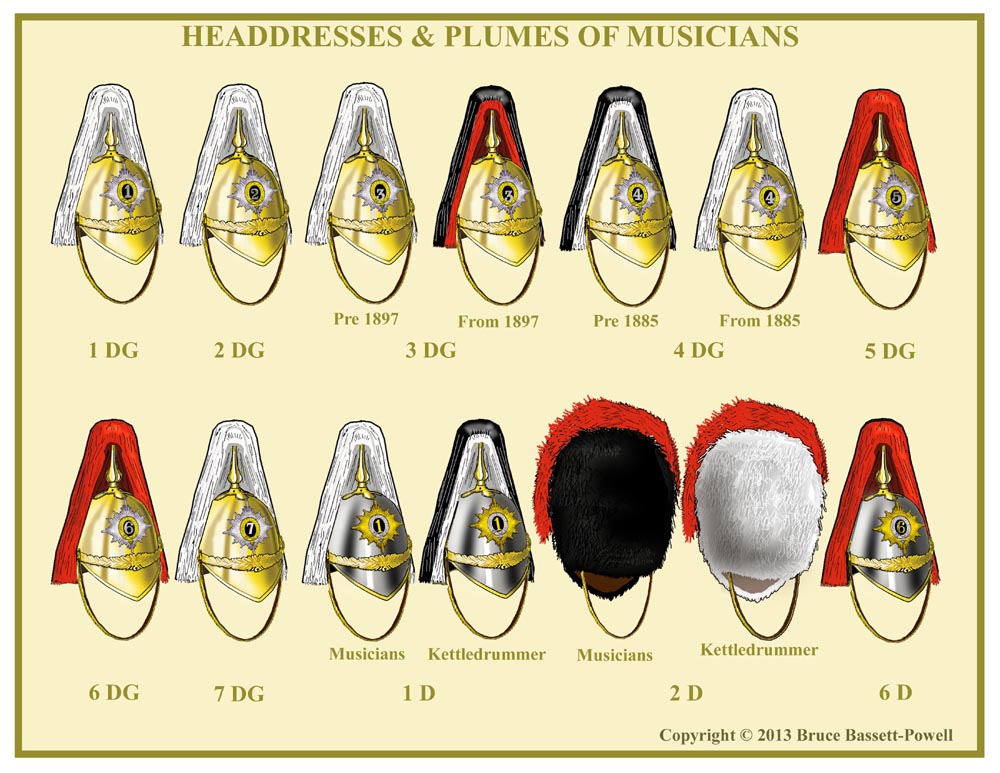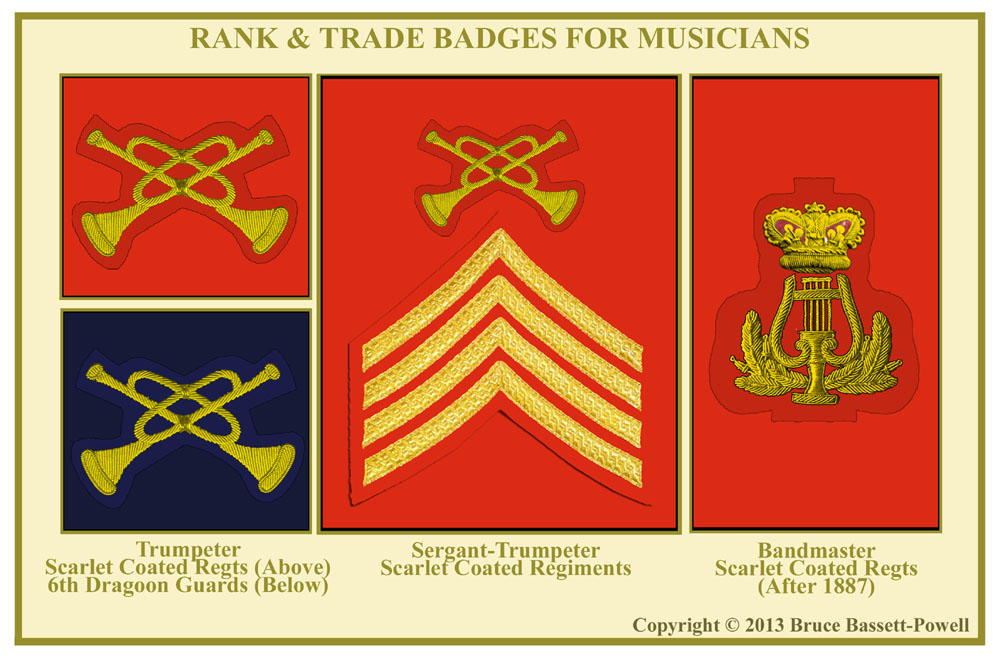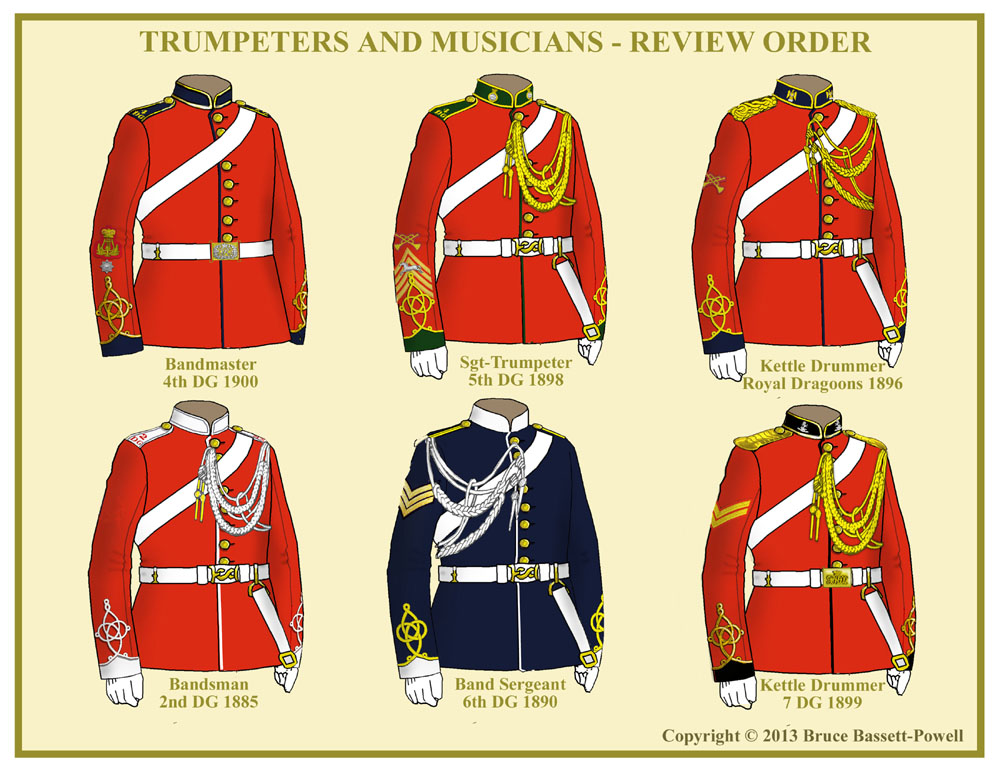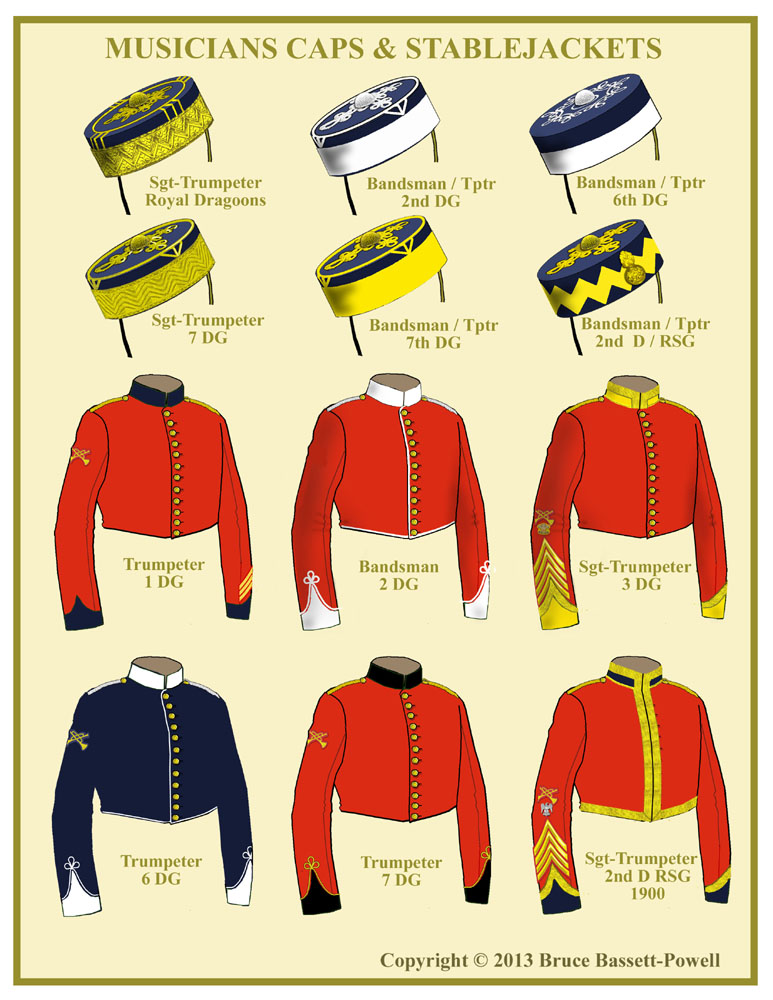HEAVY CAVALRY UNIFORMS, ARMS & EQUIPMENT - DRAGOON GUARDS & DRAGOONS
UNIFORMS OF BANDSMEN AND TRUMPETERS
HELMETS
Unlike the infantry, musicians and trumpeters in cavalry regiments basically wore the same uniforms as the other ranks. Heavy cavalry had perhaps more distinctions than hussars and lancers. In most of the regiments of Dragoon Guards and Dragoons, the helmet plume was a different colour to that of the rest of the regiment. Regulations for different coloured plumes are not always clear, but it seems to have been the province of the commanding officer and occasionally changes were made. Later in the century, it seems that the kettledrummers may have worn different plumes to the rest of the band but the only example I can find is that of the Royal Dragoons. The most famous kettledrummer distinction was the white bearskin of the 2nd Dragoons, Royal Scots Greys. The story goes and still persists, that it was presented to the regiment by Tsar Nicholas II on his appointment to Colonel-in-Chief in 1894. This account is almost certainly apocryphal as it seems to have made an appearance as early as 1885. By the end of the century, it was in use more often but by no means all the time. Of course it is worn exclusively today by the Royal Scots Dragoon Guards bass drummer and kettledrummer when they are on parade.
The plume colours were as follows
1st Dragoon Guards ……… White

2nd Dragoon Guards ……... White

3rd Dragoon Guards ……… White until 1897 then Black over Red

4th Dragoon Guards ……… Black over White until 1885 then White

5th Dragoon Guards ……… Scarlet

6th Dragoon Guards ……… Scarlet

7th Dragoon Guards ……… White

1st Dragoons ………………White – Kettledrummer Black over White after 1997 

2nd Dragoons …………….. Bearskin w Crimson plume – Kettledrummer White Bearskin*
6th Dragoons …………….. Scarlet
*Both black and white bearskins had the Hanover horse on the rear.
UNIFORMS
Among the various changes made to the rank structure in 1881 was the reduction of certain staff-sergeants 2nd class to sergeant. This included Trumpet-Majors in the cavalry and artillery and Drum, Bugle & Pipe-Majors in other branches. They would henceforth be ranked as Sergeant-Trumpeter, Sergeant-Drummer, Sergeant-Bugler and Sergeant-Piper. Despite this, they would often be referred to and described as their old ranks (unofficially, of course!). It would be 1928 before the ranks were officially restored.
The rank mark for Sergeant-Trumpeter was a four-bar chevron, points up on the lower right sleeve below the elbow. Above this were the crossed trumpets in gold bullion, bells down, on a scarlet ground (Blue for the 6th DG). For trumpeters below the rank of sergeant, the crossed trumpets were worn on the sleeve above the elbow and above chevrons (Corporal & L/Cpl).
Bandsmen did not wear any sleeve badge at all. The bandmaster’s badge of a lyre within a wreath with the crown above was authorized in 1887 and it was worn on the sleeve below the elbow. Regimental NCOs’ arm badges, where allowed, were worn between the trumpets and the chevrons for sergeant-trumpeters and below the crown & lyre for bandmasters. The bandmaster of the 4th Dragoon Guards wore the St. Patrick star below his badge prior to 1902 but not afterwards.
The tunic was for most regiments, the same as for the rest of the other ranks with band-sergeants and sergeant-trumpeters allowed to wear the first class staff tunic with gold lace. This did not appear to have been the rule in some regiments, especially those where other sergeants and above did not wear it. The entire band and trumpeters of the 7th Dragoon Guards from photographs appear to have worn a first-class tunic, certainly after 1890.
Yellow or gold aiguillettes similar to those worn by NCOs of the Household Cavalry, were worn on the left breast. In the 2nd Dragoon Guards, the aiguillettes were white. They were also white for the 6th Dragoon Guards but worn on the left breast in a different configuration than in the other regiments. The sword belt and slings were also the same as for the remainder of the cavalry. Bandmasters sometimes wore their belt and slings under the tunic like officers and wore a white belt with officer’s waist plate as in the 4th Dragoon Guards (shown). Bandsmen and trumpeters of the 7th Dragoon Guards wore their belts with a special waist plate with the Princess Royal’s cypher surmounted by the crown in relief.
Regimental commanding officers have always had a certain amount of latitude when it came to the dress of bandsmen and trumpeters as we have seen with the 7th Dragoon Guards and the Royal Scots Greys. Kettledrummers, the most flamboyant members of a cavalry regiment, have always been subject to special embellishments. In the 7th Dragoon Guards, the kettledrummer was allowed to wear special shoulder scales (as on the pre-Crimean coatee) and that of the 1st Royal Dragoons wore shoulder cords like those of NCOs in the Household Cavalry.
UNDRESS UNIFORMS FOR MUSICIANS
Although individual regiments had more influence over the undress items of their musicians and trumpeters, only a few exercised this prerogative. The pillboxes of Bandmasters and Sergeant-Trumpeters were often more elaborate than those of warrant-officers and the 7th Dragoon Guards and 1st Royal Dragoons were prime examples. The 2nd Dragoon Guards and 7th Dragoon Guards had special lacing on their pillboxes, the former in white and the latter in yellow. Trumpeters of the 6th Dragoon Guards had special figuring on the top of their caps while the Royal Scots Greys caps had a yellow vandyked band instead of white along with a brass grenade badge on the front.
Stable jackets followed the same pattern. The 2nd, 6th and 7th Dragoon Guards bandsmen and trumpeters had extra piping down the front and lower edge with crows-foot loops on the cuffs; the former two in white and the latter in yellow. Trumpet-Majors of the Royal Scots Greys wore Warrant-Officers jackets. When stable jackets were eventually discontinued in 1897, bandsmen seem to have continued wearing them for some time afterward.
There appear to have been no particular embellishments to undress frocks and field jackets apart from trumpeters badges in the same place as on the other garments.






